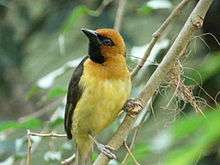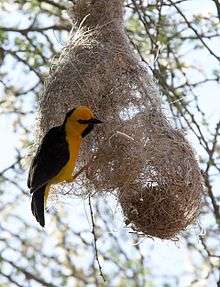Black-necked weaver
| Black-necked weaver | |
|---|---|
 | |
| Scientific classification | |
| Kingdom: | Animalia |
| Phylum: | Chordata |
| Class: | Aves |
| Order: | Passeriformes |
| Family: | Ploceidae |
| Genus: | Ploceus |
| Species: | P. nigricollis |
| Binomial name | |
| Ploceus nigricollis (Vieillot, 1805) | |
The black-necked weaver (Ploceus nigricollis) is a resident breeding bird species in much of tropical Africa from Senegal and northern Angola, South Sudan and Tanzania.
Taxonomy
The species was first described by Louis Jean Pierre Vieillot in 1805, who named it Malimbus nigricollis. The description was based on a specimen that had been collected by Jean Perrein near Malimbe, French for the town Malembo, in the Cabinda Province of Angola. The species epithet nigricollis is a contraction of two Latin words, niger meaning "black", and collis, meaning "necked".[2]
Description
The black-necked weaver is a stocky 16 cm bird with a strong conical bill. The adult male of the northern race has olive upperparts and wings, and yellow underparts and head. It has a black eyemask and bib, and a pale yellow iris. The non-breeding male has a yellow head with an olive crown, grey upperparts and whitish. The wings remain yellow and black.
The adult female also has olive upperparts and wings, and yellow underparts and head. It has a black eyemask but no bib.
The southern race found from Nigeria eastwards has a quite different appearance, with almost black upperparts and tail.
The black-necked weaver feeds on insects and vegetable matter. The calls of this bird include a wheezing dew-dew-twee .
Subspecies

There are four known subspecies:
- Ploceus nigricollis nigricollis
- Ploceus nigricollis brachypterus
- Ploceus nigricollis melanoxanthus
- Ploceus nigricollis po
Distribution and biology
This weaver occurs in forests, especially in wet habitats. It builds a large coarsely woven nest made of grass and creepers with a 15 cm downward facing entrance tunnel hanging from the globular egg chamber. The nest is suspended from a branch in a tree and 2-3 eggs are laid. It nests in pairs but forms small flocks when not breeding.
References
- ↑ BirdLife International (2012). "Ploceus nigricollis". IUCN Red List of Threatened Species. Version 2013.2. International Union for Conservation of Nature. Retrieved 26 November 2013.
- ↑ "Black-necked Weaver Ploceus nigricollis". Weaver Watch. Retrieved 2017-06-10.
- Birds of The Gambia by Barlow, Wacher and Disley, ISBN 1-873403-32-1
External links
- Black-necked weaver - Species text in Weaver Watch.
